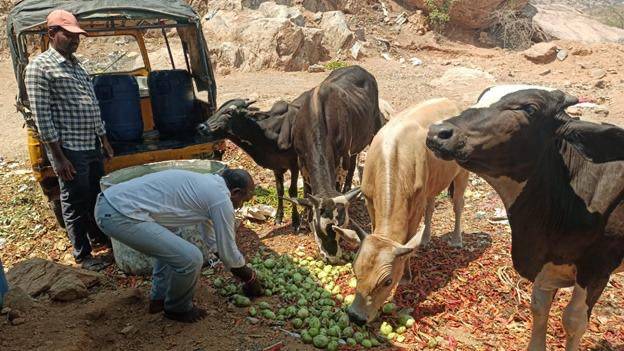[GHHF] About 20 Water Tanks for the dehydrated, thirsty animals are placed in different centers to provide Water during this scorching summer.
 “Compassion for animals is intimately associated with goodness of character, and it may be confidently asserted that he who is cruel to animals cannot be a good man.” — Arthur Schopenhauer, The Basis of Morality
“Compassion for animals is intimately associated with goodness of character, and it may be confidently asserted that he who is cruel to animals cannot be a good man.” — Arthur Schopenhauer, The Basis of Morality
The temperature is already making new records in many parts of Bharat. Both humans and animals and birds are getting dehydrated and suffering for lack of water.
Chalivendras (Water Pandals) established. Global Hindu Heritage Foundation has taken up the challenge and providing water to people in about 25 centers for the last six weeks. Many humans are having difficult to fide cold water and buttermilk.
Water Tanks for Animals
In this heat when temperature is already making new records, imagine how tough it would be for the stray animals and birds, who have no recourse from the fury Sun god! But there are ways to ensure that our furry and feathered friends make it through the season with ease, if only each one of us becomes a little mindful.
In Hinduism, animals occupy an important place. Hindus believe that animals contain the souls of their ancestors or may have been reborn. Thus, they are treated with respect. They are not to be killed for their food. In fact, Cow is regarded as the most sacred animal that needs to be protected, not killed. In fact, the Cows symbolize wealth, compassion, motherliness, righteousness (dharma), motherhood, divinity, sattvic nature, sacrifice, service, purity, and auspiciousness. In ancient India, a person’s social and economic status depended upon the number of cattle he possessed.
Many birds and animals die during summer because of severe heat stroke and dehydration. Realizing the gravity of the citizens, Global Hindu Heritage Foundation has created specialized spaces for these birds and animals to give them shelter from the heat.
We have specially ordered these water tanks, cleaned them and transported to different location s and placed them where the animals congregate the most to ensure they are provided with water.
Almost every day our Pracharaks go to these water tanks, clean them and put fresh water to make the animals have enough water to drink.
The belief that supplying water to the needy people added merit to one's life encouraged people to create water pandals and supply free drinking water to humans and animals in the country. Such practices can be seen on all days, round the year at important places especially in the temple arenas. Historically, many Temples used to arrange Water Pandals for visitors in the villages, on the side of the roadways, near Temples and so on.
Thus, for the convenience and comfort of tourists or pilgrims’ various facilities like roads, food and hospitals existed. With the infrastructure, the currency exchange system also prevailed. Moreover, almost all the houses had single or double raised platforms in front of the houses at the entry point called 'thinnai' which helped strangers and travelers to avail themselves for rest and night stay. Generally, the common public were also kind and large hearted to take care and spare food and water to the travelers from far and near. This is how the whole system of tourism functioned in Medieval South India, she added.
Your donations are appreciated;
By Zelle: ghhfusaorg@gmail.com
By PayPal: savetemples.org
By Check: Or you can send a check payable to GHHF, 14726 Harmony Lane, Frisco, TX 75035.
It is tax-deductible.
By Rupees: call 601-918-7111; +91 83096 43979.





















 Urgent support needed for Bangladesh Hindus
Urgent support needed for Bangladesh Hindus 







